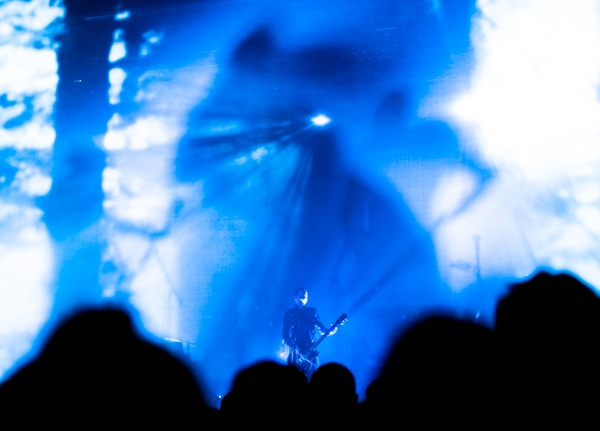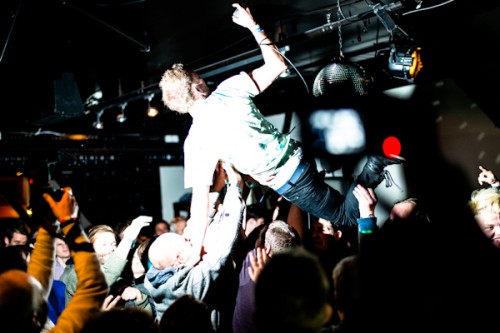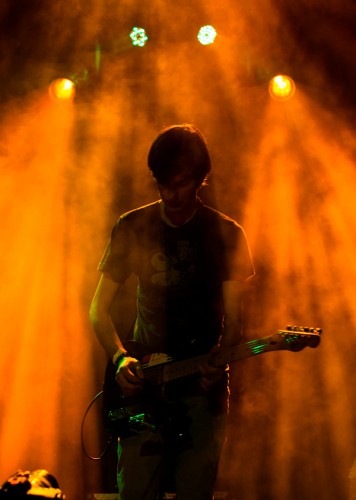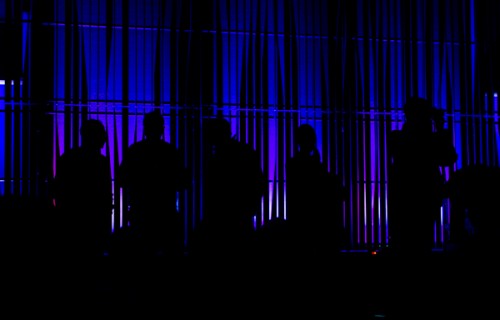
Little known fact: I profoundly dislike going to events longer than four or five hours entirely by myself. Though I enjoy my own company, and have a visceral need for regular time alone, one thing I really do not enjoy (understatement) is awkwardly standing alone in a crowd of complete strangers who are having conversations. This doesn’t stop me from going to all sorts of things by myself, as I have an even stronger dislike of missing out on events that seem interesting, exciting, or useful to me. But as someone who falls somewhere between “awkward at” and “terrified of” approaching people she doesn’t yet know, there’s a certain level of OH GOD OH GOD OH GOD involved each time I have to contemplate keeping myself socially occupied for longer than an average night of rock shows.
How do I deal with this? Put simply: Twitter.
Ever since ROFLCon 2008—which is what got me on Twitter in the first place[i]—being on Twitter has helped to ameliorate some of my Solo Introvert’s Event Anxiety. I may not “know” people after exchanging a few comments with them on a hashtag, but those people aren’t exactly strangers either; approaching to ask, “Hey, are you <username>?” feels far less overwhelming and potentially intrusive than do other ways of initiating a first-ever in-person conversation with someone. What’s even better is that, since I look like my user icon, other people often recognize me and do the work of approaching to say “hello” instead (which I think is awesome); in fact, I can thank one such pair of interactions for the fact that I write for this blog. (Yay, Twitter!)
Recently I’ve been thinking a lot about the relationship between digitally-mediated sociality and in-person sociality, mainly because I spent last week solo-attending a five day event with only intermittent access to the Internet—and it turns out that few things make me contemplate digitally-mediated sociality the way being unwillingly cut off from it does. From Wednesday of last week to Tuesday of this week, I was in Reykjavík, Iceland for Iceland Airwaves 2012. I love this music festival, and was super-excited last spring when I made plans to attend it for the second time. There was a key difference between my experiences of Airwaves 2012 and Airwaves 2010, however, and that difference was this: by 2012, I’d learned the hard way that just because I can use my phone in Iceland doesn’t mean I should use my phone in Iceland. (Three words: “data roaming,” and “ouch.”) The plan was therefore to run wifi-only for #Airwaves12.
It was really hard.

There’s a lot of free wifi in Reykjavík, and a fair number of networks that are even unsecured. At the same time, many of the smaller festival venues didn’t have wifi, and the wifi in my apartment for the week was touch-and-go. Even when a venue had wifi, getting on it was sometimes difficult or impossible: Airwaves is an international festival, and I certainly wasn’t the only attendee fiendishly jumping on any hint of a signal, desperate for digital data. Even when I had wifi, I couldn’t communicate in all the ways I usually do; text messaging my friends who don’t use iPhones, for example, wasn’t an option. Suddenly I was almost painfully aware of how many functions my glowing rectangle serves for me (why do we still call it a phone?): I use my pocket computer and its portable Internet access not just to stay in touch with people but also to stay in touch with the world, to feel that I’m a part of the world at all. I use it to feel that I have a voice, and can speak, and can be heard, even if only by tracking algorithms and packet switchers that will never respond in any way I can understand. (And don’t even get me started about how much I apparently depend on scrolling through Twitter on my phone—read also: alarm clock—in order to wake up in the morning.)
The difficulty of getting online as an international visitor in Reykjavík shaped my experience of the festival on two levels, and not just because I kept oversleeping as I adjusted to life on Greenwich Mean Time. There’s the obvious personal/individual level, which is the fact that it was far more difficult for me at Airwaves to participate on the event hashtag, to document my experiences in the moment, and to use Twitter as a way to meet and interact with other event attendees. But there’s also the collective level effect, which is how the character of hashtag participation and other digital interaction itself may have been affected by the fact that a large portion of festival attendees had only limited mobile Internet access.
One member of a local Reykjavík band told me that, although his band had started an account, they didn’t use it very much—and that Twitter use in general isn’t very common in Iceland. If he was correct, this means that the people who had the easiest access to Twitter during the festival were also among the least likely to be on Twitter in the first place. There’s no way to know, of course, how many people would have been using Twitter at Airwaves if everyone had had reliable, non-roaming data coverage. It’s also important to acknowledge that my observations of hashtag participation are based only on tweets that were in English (roughly 60 to 70 percent of the tweets I saw), and that I was only following the official hashtag. Hashtag interaction in other languages may have been different, and my own experience might have been different if I was fluent in more than just English (particularly if I spoke Íslenska). Interaction may also have been different on some of the unofficial hashtags I saw pop up from time to time, such as #airwaves2012.
What first struck me about the #airwaves12 tag was twofold. First, although there were a fair number of posts being made to the hashtag, there weren’t a lot of conversations happening on it. Most posts were originating tweets rather than responses to other tweets, as if the majority of tweeting attendees were using the #airwaves12 hashtag only to draw more attention to their applicable tweets rather than also to interact with each other.

Second, cross-posts from Instagram made up a substantive portion (at times more than half) of the hashtag traffic. Some of the ways this differed from what I’m used to are undoubtedly due to the nature of the event itself: pretty light shows are more Instagrammable than are, say, most conference presentations, and pretty pictures more often prompt “likes” back on Instagram than verbal comments on Twitter. The very existence of Instagram, too, seems to promote photo sharing on Twitter in ways that less-Social photo hosting platforms (like Flickr, TwitPic, or Twitter’s own image hosting service) didn’t during Airwaves 2010. Not only did I see more photos posted this year, but almost every photo I saw posted to #airwaves12 (and every photo I posted to the hashtag myself: guilty) was an Instagram photo. Instagram does use hashtags, but the conversation each pulls up is written in pictures rather than words; if a Twitter hashtag can call up a public commons, an Instagram hashtag calls up an array of smaller rooms (images) with unlocked doors, which may or may not have verbal dialogue going on within them.
What it took me a night of thwarted hashtag participation and under-augmented show-going to realize, however, was that Instagram’s heavy presence on #airwaves12 may also have been due, in part, to the fact that many attendees (presumably) didn’t have constant mobile Internet access. Why? Because at least in my experience, the temporality of Instagram is more conducive to expressions of the recent past than is the temporality of Twitter. (Instagram’s faux vintage photos encourage us to see our present as always a future past, after all, whereas Twitter invites you to “find out what’s happening, right now, with the people and organizations you care about.”) Just like you wouldn’t live tweet a debate after it aired, you wouldn’t give detailed, multi-tweet descriptions of a show that happened hours ago; you can have a couple Instagram shots backed up for the next time you hit a wifi hotspot, but posting a night’s worth of backed up tweets in one fell swoop would feel strange and out of place. (Trust me: posting even half a night’s worth of tweets feels like Doing It Wrong.)
Yes, there’s the “insta” in Instagram, and people do frequently post pictures taken “in the now”; likewise, it wouldn’t be abnormal to tweet “<band name> was awesome last night!” But while whether one posts in the moment or after the fact has little impact on what one might post to Instagram, this distinction does impact what one might post to Twitter. “This set is awesome!” can easily convert to “That set was awesome!” on either Instagram or Twitter, but many of Twitter’s other uses are temporality-dependent and don’t work in after-tweeting. There’s no point in asking about queue length once the show in question is over, for example, and it doesn’t do much good to find out the next morning which shows a majority of people were planning to attend last night.

Critically, many of the ways that one might initiate tweeted conversations with strangers in the absence of public hashtag repartee are temporality-dependent. Sending an @reply to a stranger to ask about the show they just said they’re at makes sense (“how’s <band name>, are they any good?”), but sending an @reply to a stranger to ask the same question about the show they were at two days ago is a lot more personal. Why are you asking that person in particular, when you could scroll back and read everything that got posted on the hashtag afterward? Questions do not convert across time as easily as do plain documentary statements; removed from the immediacy of their original moments, questions require additional framing, some explanation of why they’re being asked and directed as they are. Without some sort of additional information—for example, “I really wanted to see <band name>, but it was the same time as the <other band name> show. What did you think?”— temporally-dislocated questions to strangers can run the risk of seeming tangential, untoward, or even ‘creepy’.
Accordingly, what I saw on the #airwaves12 hashtag was a lot of statements (whether in pictures, words, or both), and very few questions. The few questions I did see go by rarely got on-hashtag answers; the handful of questions I asked got almost no responses at all. The one exception was the day I (thankfully!) discovered another hashtag: #rvktweetup, for Reykjavík Tweetup. After I tweeted that I wished I’d discovered #rvktweetup earlier, the organizer tweeted back to tell me I could still make that day’s gathering; some more back-and-forth communicated the logistics, and 20 minutes later I’d finally met some other festival attendees via Twitter. The tweetup was (of course) at a wifi-enabled location, and those of us who weren’t already following each other were able to do so before we parted ways. This was an important step: it’s what allowed a relatively brief encounter to become a collection of ongoing contacts and connections, rather than simply dissipate and return us all to the anonymous crowd.
This, to me, is part of the beauty of cybersociality: the cybersocial synergy of digital sociality and in-person sociality fueling and reinforcing each other, creating and often deepening connections as they do so. I’ve stayed in touch with some of the people I met at Airwaves in 2010, and I’m planning to stay in touch with a number of the people I met at Airwaves this year; eventually, some combination of personal schedules will work out such that I’ll go to Airwaves and actually know other attendees before the festival is half-over. I was also fortunate enough to meet up with friends of a Twitter friend after Airwaves ended: a gathering over pints was coordinated (via Twitter) after I was introduced (via Twitter), and since I started following the people I met that night, I’ll be staying in touch (via Twitter) with my new friends in Reykjavík, too.
Obviously, cybersocial synergy doesn’t just apply to music festivals; for instance, though it’s still 2012, I’m already gleefully looking forward to seeing many of the people that I met at #TtW12 next year at Theorizing the Web 2013. But cybersocial synergy also isn’t limited to events with hashtags; sometimes the ‘event’ is a wonderful ever-expanding meet-up at which you find yourself suddenly plugged into a preexisting network. Sometimes the ‘event’ is sitting down with a new contact over coffee, or a chance meeting at a bus stop in the city where you live.

For the first large chunk of Airwaves 2012, I tried, and failed, to meet people without using Twitter—and did a lot of that awkward standing by myself stuff between sets (while writing short statements I couldn’t tweet and cropping phone photos into square-shaped images I couldn’t post). Some people might claim that this is because digital sociality has destroyed my ability to interact with other people “in real life” (or something), but digital sociality and in-person sociality are not zero-sum; I’m frankly at my lifetime high point for Stranger Interaction Skills, and that’s certainly not in spite of my engagement with social media.
That said…I still really hope they expand wifi access at Airwaves 2013.
Whitney Erin Boesel is obviously on Twitter. You can follow her! She’s @phenatypical.
All photos by Whitney Erin Boesel. Used with permission.
[i] Full disclosure: When a friend first described Twitter to me in the fall of 2007, I thought it was quite possibly the stupidest thing I’d ever heard. “You text 40404 to tell people where you are and what you’re doing, and then it sends the text message out to all your friends!” He thought this was great; my thought was, “Why on earth would I want everyone to know where I am and what I’m doing? That sounds terrible!”
Eight months later at ROFLCon, when one of us could participate on the hashtag (and find out about the afterparties) and one of us couldn’t, I saw the light—and borrowed a stranger’s laptop in the middle of a nightclub to start my first account.

Comments 2
In Their Words » Cyborgology — November 11, 2012
[...] “few things make me contemplate digitally-mediated sociality the way being unwillingly cut off from i...” [...]
The Spotification Diaries » Cyborgology — September 21, 2013
[...] being billed. Something else was going on, though: I was preparing to travel to Reykjavík for Iceland Airwaves 2012. When I’d attended Iceland Airwaves 2010, all I’d had to go on for choosing which bands to [...]